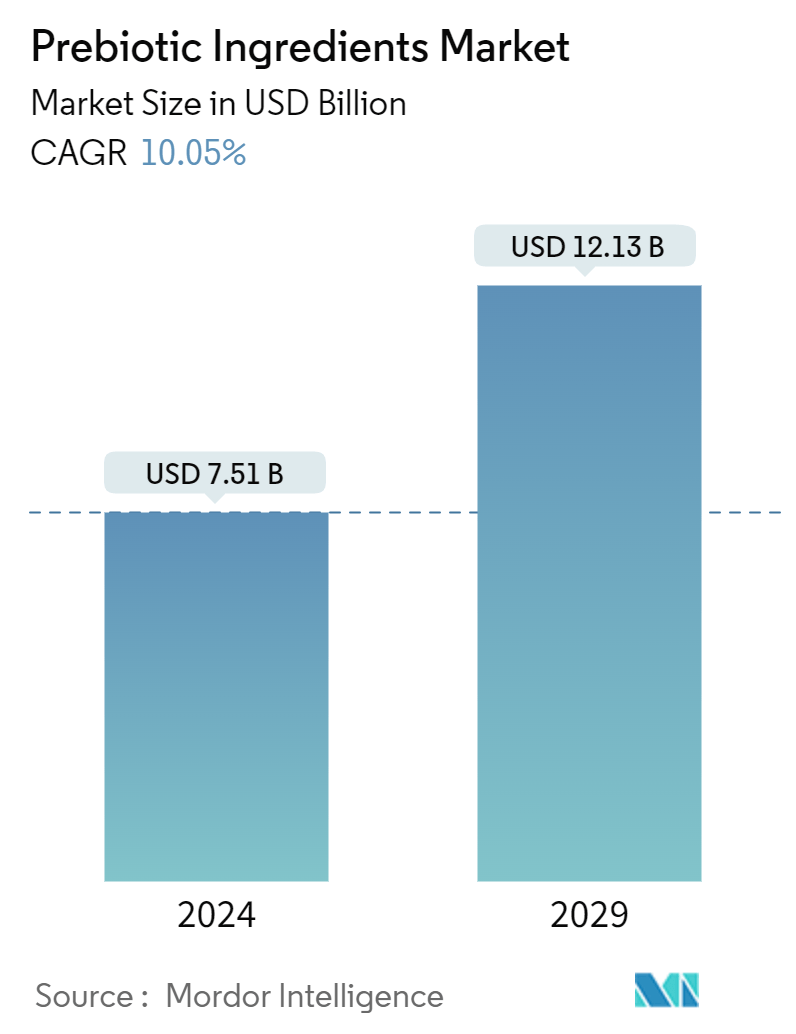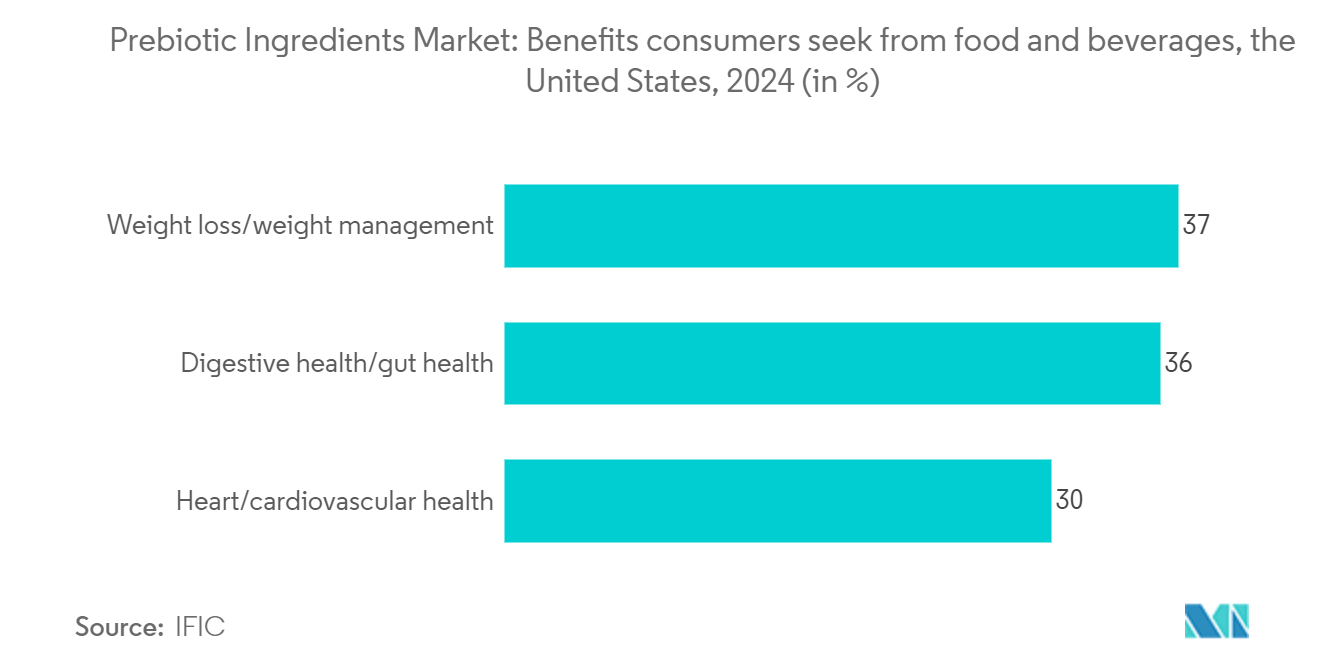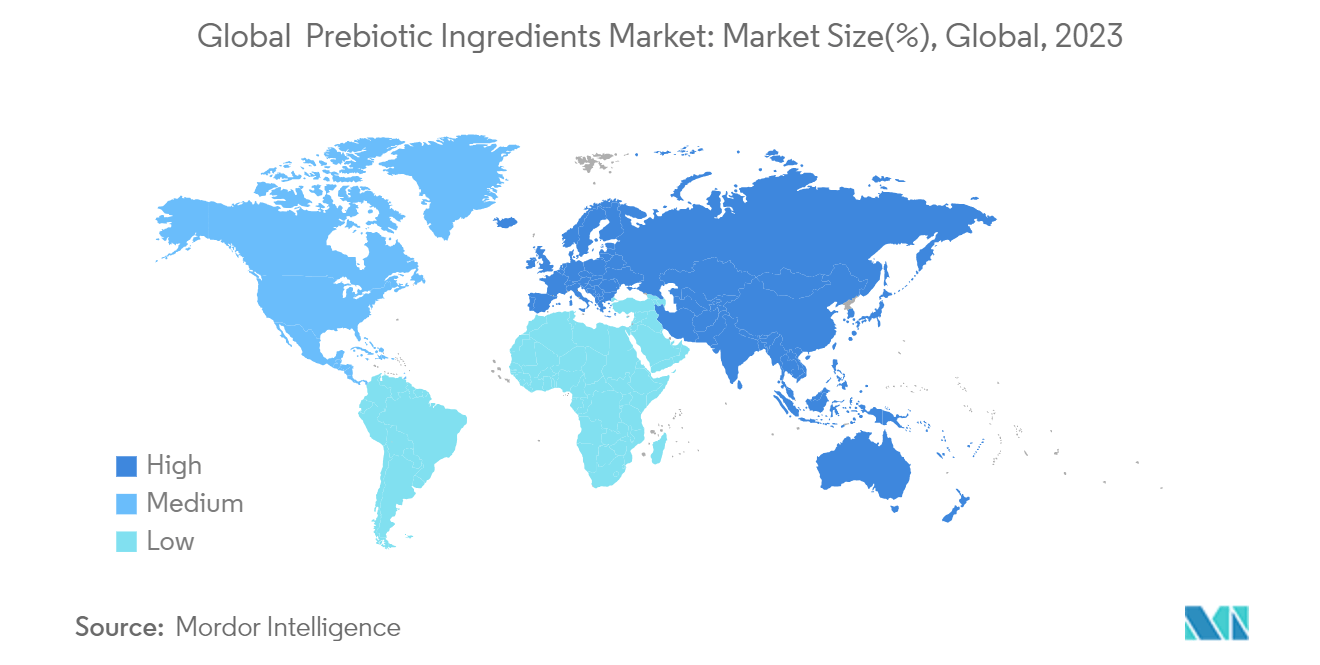Prebiotic Ingredients Market Size

| Study Period | 2019 - 2029 |
| Market Size (2024) | USD 7.51 Billion |
| Market Size (2029) | USD 12.13 Billion |
| CAGR (2024 - 2029) | 10.05 % |
| Fastest Growing Market | South America |
| Largest Market | Europe |
Major Players.webp)
*Disclaimer: Major Players sorted in no particular order |
Prebiotic Ingredients Market Analysis
The Prebiotic Ingredients Market size is estimated at USD 7.51 billion in 2024, and is expected to reach USD 12.13 billion by 2029, growing at a CAGR of 10.05% during the forecast period (2024-2029).
The prebiotic ingredients market is a dynamic sector within the broader functional foods market. Prebiotic ingredients are essential for maintaining and improving gut health, driving demand in various applications such as functional food and beverages, dietary supplements, and animal feed. These ingredients include inulin, fructooligosaccharides (FOS), and galactooligosaccharides (GOS), each playing a vital role in promoting digestive health by fostering beneficial gut bacteria. The rising consumer awareness of digestive health and the benefits of prebiotics over probiotics is significantly influencing market developments.
Rising Consumer Focus on Digestive Health
- Consumer awareness and demand: The increasing awareness of gut health and its impact on overall well-being has driven the demand for prebiotic ingredients across various applications. Consumers are increasingly seeking products that enhance their digestive health, leading to a surge in demand for prebiotic supplements, prebiotic fiber, and prebiotic foods. This trend is reflected in the growing gut health market, where consumers prioritize ingredients that contribute to digestive wellness.
- Preventive healthcare trends: The growing emphasis on preventive healthcare has resulted in a preference for natural and functional ingredients like prebiotics, which are recognized for their ability to improve gut health and strengthen the immune system. Research linking gut health to several chronic conditions, including obesity, diabetes, and cardiovascular diseases, further supports this trend, making prebiotic ingredients a crucial component in the functional foods market.
- Prebiotic benefits and consumer knowledge: This heightened awareness is further supported by a plethora of research linking gut health to several chronic conditions, including obesity, diabetes, and cardiovascular diseases. As a result, the integration of prebiotic ingredients into a wide range of food products, such as yogurts, cereals, and snack bars, is becoming increasingly common. Consumers are now more informed about the differences between prebiotics and probiotics, with prebiotics gaining traction due to their role in feeding beneficial gut bacteria.
- Expanding market for prebiotic powders: Additionally, the market for prebiotic powders is expanding, driven by their ease of use and versatility in various food and beverage formulations. The functional foods market is thus witnessing a steady increase in the incorporation of prebiotic ingredients, with food manufacturers innovating to meet consumer demand for gut-friendly products. Prebiotic powders offer a convenient way for consumers to integrate gut health-promoting ingredients into their daily diets, enhancing market growth.
Challenges in Sourcing and Consistency of Prebiotic Ingredients
- Sourcing challenges: Despite the promising growth of the prebiotic ingredients market, the industry faces challenges related to the sourcing and consistency of high-quality ingredients. The extraction and processing of prebiotic fibers such as inulin and FOS require specific agricultural inputs, which can be subject to seasonal variations and supply chain disruptions. These factors can impact the availability and pricing of prebiotic ingredients, posing a challenge for manufacturers seeking to maintain product consistency and meet consumer demand.
- Complexity in formulations: The industry also faces challenges related to the complexity of the digestive health market. With a wide range of products available, from dietary supplements to functional foods, ensuring the efficacy and stability of prebiotic ingredients across different applications can be challenging. This is particularly relevant in the synbiotic market, where prebiotics and probiotics are combined to deliver enhanced health benefits. Achieving the right balance between these components requires sophisticated formulation techniques, which can add to production costs and complexity.
- Regulatory landscape: Furthermore, regulatory standards for prebiotic ingredients vary across different regions, adding another layer of complexity for global manufacturers. Ensuring compliance with these regulations while maintaining the health benefits of prebiotic ingredients is crucial for market leaders. This regulatory landscape can impact industry outlook, as companies navigate the challenges of meeting different market requirements.
- Need for innovation: In summary, the prebiotic ingredients market is poised for significant growth, driven by rising consumer awareness of gut health and the benefits of prebiotics. However, challenges related to sourcing, consistency, and regulatory compliance will need to be addressed to sustain this growth. Market leaders will play a crucial role in overcoming these challenges by investing in research and development to innovate and maintain the quality of prebiotic ingredients across various applications.
Prebiotic Ingredients Market Trends
Evolving Preference for Improved Gut Health
- Increasing demand: The prebiotic ingredients market is growing rapidly due to heightened consumer awareness about gut health. As more individuals recognize the advantages of prebiotics for both human and animal nutrition, the demand for products like prebiotic supplements, fiber, and foods has surged. This trend is fueled by the shift towards healthier lifestyles, with prebiotics being favored over probiotics due to their role in enhancing gut flora and overall digestive health. As consumers seek out functional foods that offer clear health benefits, the prebiotic market is becoming a key segment within the broader functional foods industry.
- Rising popularity of prebiotic fibers: Prebiotic fibers, such as inulin and fructooligosaccharides (FOS), are increasingly incorporated into everyday foods like yogurt, cereals, and beverages. These ingredients not only support gut health by promoting beneficial bacteria growth but also appeal to consumers looking for easy ways to improve their diet. With a growing number of products highlighting their prebiotic content, manufacturers are capitalizing on the trend by innovating and expanding their product lines. This surge in demand for prebiotic-rich foods is a significant driver of the market’s expansion, as consumers prioritize digestive health.
- Animal nutrition as a growth driver: In the animal nutrition sector, prebiotics are becoming essential for enhancing livestock health and productivity. By improving gut flora balance, these ingredients lead to better nutrient absorption and overall animal health, reducing the reliance on antibiotics. As the demand for natural and antibiotic-free animal products grows, so does the use of prebiotics in animal feed. This trend aligns with the broader movement towards sustainable and health-focused agricultural practices, further propelling the prebiotic ingredients market.
- Growth of the synbiotic market: The synbiotic market, which combines prebiotics and probiotics, is experiencing significant growth. These products are popular because they offer a dual benefit by supporting both the growth of beneficial bacteria and the introduction of new strains into the gut. This comprehensive approach to digestive health is appealing to consumers who are increasingly looking for products that provide multiple health benefits. The rising interest in synbiotics is driving innovation and expanding the market for both human and animal nutrition products.

The Prebiotic Ingredients Market is Dominated by the Europe Region
- Europe's market leadership: Europe continues to lead the global prebiotic ingredients market, driven by early adoption of functional foods and high consumer awareness of digestive health benefits. The region’s market dominance is supported by a strong infrastructure of suppliers and manufacturers who focus on innovation and product development. European consumers, who demand transparency and efficacy in the products they consume, are driving the market forward, particularly with a preference for prebiotic inulin, a widely recognized ingredient for its health benefits.
- Regulatory impact on growth: The European market is characterized by strict food safety regulations and a well-informed consumer base that values the health benefits of prebiotic ingredients. This has led to increased consumption of prebiotic supplements and foods, especially those containing prebiotic inulin. As the aging population in Europe becomes more concerned with preventive healthcare, the demand for gut health products is expected to rise, ensuring continued market growth.
- Convenience of prebiotic powders: Prebiotic powders have gained popularity in Europe due to their versatility and ease of incorporation into various food and beverage applications. These products appeal to health-conscious consumers who want to improve their gut health without making drastic changes to their diets. The convenience of prebiotic powders has made them a preferred choice, contributing to the market's expansion across the region.
- Promising market outlook: The future of the prebiotic ingredients market in Europe looks promising, with continuous research and development aimed at enhancing the efficacy and application of these ingredients. As the market value is projected to grow steadily, Europe is expected to maintain its leadership position. The ongoing focus on health and wellness products, supported by industry trends and consumer preferences, will continue to drive market expansion in the coming years.

Prebiotic Ingredients Industry Overview
- Fragmented market dynamics: The global prebiotic ingredients market is characterized by a fragmented landscape, with numerous players operating at various levels of the supply chain. This fragmentation is driven by the diversity of applications for prebiotics across industries, including food & beverages, dietary supplements, and animal feed, among others. While global companies hold a significant market share, the presence of specialized local players contributes to the competitive nature of this market. The market’s fragmentation indicates ample opportunities for regional players to carve out niches, particularly in the functional food and nutraceutical segments.
- Dominance of global companies: The major players in the prebiotic ingredients market include Tereos Group, Ingredion Incorporated, Cargill Inc., Kerry Group, and Royal FrieslandCampina N.V. These companies dominate due to their extensive distribution networks, strong R&D capabilities, and wide product portfolios that cater to various applications. Their dominance is also bolstered by strategic acquisitions and partnerships that enhance their market presence and product offerings. Additionally, their ability to innovate and scale production in response to growing consumer demand for prebiotic-rich products keeps them ahead of smaller competitors.
- Innovation-driven success: In this evolving market, success will hinge on innovation, particularly in the development of new prebiotic formulations that cater to specific health benefits. Companies that invest in R&D to explore new sources of prebiotic ingredients and that collaborate with academic and research institutions are likely to maintain a competitive edge. Furthermore, understanding and addressing regional consumer preferences, as well as ensuring compliance with varying regulatory standards, will be crucial for companies looking to expand their market share.
- Strategic growth opportunities: The global prebiotic ingredients market offers substantial opportunities for growth, particularly in regions where consumer awareness of gut health is on the rise. Companies that can navigate the complexities of sourcing, regulatory compliance, and product innovation will be well-positioned to capitalize on the expanding demand for prebiotic ingredients. The competitive landscape will continue to evolve as market players leverage strategic partnerships, acquisitions, and new product developments to strengthen their positions.
Prebiotic Ingredients Market Leaders
-
Tereos Group
-
Ingredion Incorporated
-
Cargill Inc
-
Kerry Group
-
Royal FrieslandCampina N.V.
*Disclaimer: Major Players sorted in no particular order

Prebiotic Ingredients Market News
- May 2024: Founded in 2019, Gutzy Organic is swiftly positioning itself at the forefront of the prebiotic snack market, riding the wave of increasing consumer focus on wellness. Recognizing the rising consumer emphasis on gut health, Gutzy Organic has been proactive in leveraging this trend. This month, the pouch manufacturer unveiled a fresh packaging design and introduced a new flavor: botanical turmeric and mango. This new addition complements Gutzy's existing offerings, which include flavors like Apple Spinach Kiwi Kale and Apple Strawberry Blueberry + Turmeric Dandelion. Notably, all of the company's products are fortified with 5 grams of prebiotic acacia.
- March 2024: NutriLeads unveiled five product options for Benicaros, its clinically validated precision prebiotic and immune-training fiber, catering to diverse formulation needs in foods, beverages, and dietary supplements. The newly expanded lineup features Benicaros with different concentration levels of its active ingredient, Rhamnogalacturonan-I (RG-I), facilitating larger daily serving sizes. These purity variations not only comply with European regulatory standards but also cater to a broad spectrum of application requirements. Notably, Benicaros is sustainably derived from upcycled carrot pomace.
- March 2024: Beech-Nut Nutrition Company, a prominent player in the baby and toddler food industry, unveils seven innovative food and snack products made with ingredients such as prebiotics, whole milk yogurt, fruits, and vegetables.
Prebiotic Ingredients Market Report - Table of Contents
1. INTRODUCTION
- 1.1 Study Deliverables and Study Assumptions
- 1.2 Scope of the Study
2. RESEARCH METHODOLOGY
3. EXECUTIVE SUMMARY
4. MARKET DYNAMICS
-
4.1 Market Drivers
- 4.1.1 Increased Focus on Gut Health
- 4.1.2 Awareness of Health Benefits of Prebiotics
-
4.2 Market Restraints
- 4.2.1 Sourcing Challenges
- 4.2.2 Diverse Regulatory Standards
-
4.3 Porter's Five Forces Analysis
- 4.3.1 Threat of New Entrants
- 4.3.2 Bargaining Power of Buyers/Consumers
- 4.3.3 Bargaining Power of Suppliers
- 4.3.4 Threat of Substitute Products
- 4.3.5 Intensity of Competitive Rivalry
5. MARKET SEGMENTATION
-
5.1 By Type
- 5.1.1 Inulin
- 5.1.2 Fructooligosaccharide (FOS)
- 5.1.3 Galactooligosaccharide (GOS)
- 5.1.4 Other Types
-
5.2 By Application
- 5.2.1 Functional Food and Beverage
- 5.2.2 Infant Formula and Baby Food
- 5.2.3 Dietary Supplements
- 5.2.4 Animal Feed
- 5.2.4.1 Ruminant
- 5.2.4.2 Poultry
- 5.2.4.3 Swine
- 5.2.4.4 Aquaculture
- 5.2.4.5 Other Animal Feed
- 5.2.5 Pet Food
-
5.3 By Geography
- 5.3.1 North America
- 5.3.1.1 United States
- 5.3.1.2 Canada
- 5.3.1.3 Mexico
- 5.3.1.4 Rest of North America
- 5.3.2 Europe
- 5.3.2.1 Spain
- 5.3.2.2 United Kingdom
- 5.3.2.3 Germany
- 5.3.2.4 France
- 5.3.2.5 Italy
- 5.3.2.6 Russia
- 5.3.2.7 Rest of Europe
- 5.3.3 Asia-Pacific
- 5.3.3.1 China
- 5.3.3.2 Japan
- 5.3.3.3 India
- 5.3.3.4 Australia
- 5.3.3.5 Rest of Asia-Pacific
- 5.3.4 South America
- 5.3.4.1 Brazil
- 5.3.4.2 Argentina
- 5.3.4.3 Rest of South America
- 5.3.5 Middle-East and Africa
- 5.3.5.1 South Africa
- 5.3.5.2 Saudi Arabia
- 5.3.5.3 Rest of Middle-East and Africa
6. COMPETITIVE LANDSCAPE
- 6.1 Strategies Adopted by Key Players
- 6.2 Market Positioning Analysis
-
6.3 Company Profiles
- 6.3.1 Tereos Group
- 6.3.2 Ingredion Incorporated
- 6.3.3 Cargill Inc.
- 6.3.4 DuPont de Nemours Inc.
- 6.3.5 Kerry Group
- 6.3.6 Yakult Honsha Co. Ltd
- 6.3.7 Cosucra Groupe Warcoing SA
- 6.3.8 Sensus BV
- 6.3.9 Nexira SAS
- 6.3.10 Roquette Freres
- *List Not Exhaustive
7. MARKET OPPORTUNITIES AND FUTURE TRENDS
** Subject To AvailablityPrebiotic Ingredients Industry Segmentation
A prebiotic is an ingredient that undergoes selective fermentation, leading to specific alterations in the composition and activity of gastrointestinal microflora, ultimately benefiting host health and well-being.
The prebiotic ingredients market is segmented by type, application, and geography. By type, the market is segmented into inulin, fructooligosaccharide, galactooligosaccharide, and other types. By application, the market is segmented into functional food and beverage, infant formula and baby food, dietary supplements, animal feed, and pet food. Animal feed is further sub-segmented into ruminant, poultry, swine, aquaculture, and other animal feed. By geography, the market has been segmented into North America, Europe, Middle East & Africa, Asia-Pacific, and South America.
For each segment, the market sizing and forecasting have been done in value terms of USD.
| By Type | Inulin | |
| Fructooligosaccharide (FOS) | ||
| Galactooligosaccharide (GOS) | ||
| Other Types | ||
| By Application | Functional Food and Beverage | |
| Infant Formula and Baby Food | ||
| Dietary Supplements | ||
| Animal Feed | Ruminant | |
| Poultry | ||
| Swine | ||
| Aquaculture | ||
| Other Animal Feed | ||
| Pet Food | ||
| By Geography | North America | United States |
| Canada | ||
| Mexico | ||
| Rest of North America | ||
| By Geography | Europe | Spain |
| United Kingdom | ||
| Germany | ||
| France | ||
| Italy | ||
| Russia | ||
| Rest of Europe | ||
| By Geography | Asia-Pacific | China |
| Japan | ||
| India | ||
| Australia | ||
| Rest of Asia-Pacific | ||
| By Geography | South America | Brazil |
| Argentina | ||
| Rest of South America | ||
| By Geography | Middle-East and Africa | South Africa |
| Saudi Arabia | ||
| Rest of Middle-East and Africa |
Prebiotic Ingredients Market Research FAQs
How big is the Prebiotic Ingredients Market?
The Prebiotic Ingredients Market size is expected to reach USD 7.51 billion in 2024 and grow at a CAGR of 10.05% to reach USD 12.13 billion by 2029.
What is the current Prebiotic Ingredients Market size?
In 2024, the Prebiotic Ingredients Market size is expected to reach USD 7.51 billion.
Who are the key players in Prebiotic Ingredients Market?
Tereos Group, Ingredion Incorporated, Cargill Inc, Kerry Group and Royal FrieslandCampina N.V. are the major companies operating in the Prebiotic Ingredients Market.
Which is the fastest growing region in Prebiotic Ingredients Market?
South America is estimated to grow at the highest CAGR over the forecast period (2024-2029).
Which region has the biggest share in Prebiotic Ingredients Market?
In 2024, the Europe accounts for the largest market share in Prebiotic Ingredients Market.
What years does this Prebiotic Ingredients Market cover, and what was the market size in 2023?
In 2023, the Prebiotic Ingredients Market size was estimated at USD 6.76 billion. The report covers the Prebiotic Ingredients Market historical market size for years: 2019, 2020, 2021, 2022 and 2023. The report also forecasts the Prebiotic Ingredients Market size for years: 2024, 2025, 2026, 2027, 2028 and 2029.
Prebiotic Ingredients Industry Report
Our in-depth industry research on the prebiotic ingredients market provides comprehensive insights into current trends, challenges, and opportunities within this rapidly growing sector. The report covers key market drivers, including the increasing consumer focus on digestive health and the shift towards preventive healthcare, which is fueling demand for prebiotic supplements, prebiotic fiber, and prebiotic foods. With a detailed analysis of market segments, such as prebiotic oligosaccharides and the synbiotic market, stakeholders gain a thorough understanding of the industry's dynamics. The report pdf also explores the competitive landscape, highlighting innovation as a critical factor for success.
Stakeholders in the prebiotic ingredients market benefit from our report's data-driven approach, offering valuable industry information and market predictions that support strategic decision-making. The industry report delves into regional market trends, particularly Europe's dominance, and examines challenges like sourcing consistency and regulatory compliance. By accessing this industry report, businesses can stay ahead of market trends, optimize their product offerings, and capitalize on growth opportunities. All these insights are available in an easy-to-read report pdf format, ensuring that industry leaders have the information they need to navigate the evolving market landscape effectively.
Statistics for the 2024 Prebiotic Ingredients market share, size and revenue growth rate, created by Mordor Intelligence™ Industry Reports. Prebiotic Ingredients analysis includes a market forecast outlook to 2029 and historical overview. Get a sample of this industry analysis as a free report PDF download.



